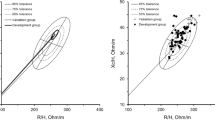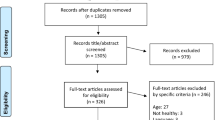Abstract
Most of the research in body composition of young soccer players has used anthropometric techniques as assessment methods. On the other hand, there is lack of data concerning bioelectrical impedance analysis (BIA) in young soccer players, a method which might provide more detailed information on body composition than the traditional anthropometric techniques.
Purpose
Therefore, the aim of this study was to examine body composition assessed by BIA of young soccer players with regard to their age and playing position.
Methods
We examined the body composition of 65 soccer players (age 15.2 ± 0.2 years, weight 63.3 ± 9.4 kg, height 171.5 ± 8.3 cm and training experience of 9.0 ± 1.5 years), classified into three age groups (U14, ~13 years; U16, ~15 years; and U18, ~17 years) and four playing positions (goalkeepers, defenders, midfielders and forwards).
Results
U14 showed lower weight, BMI, intracellular and extracellular water, protein, mineral mass, basal metabolism and all parameters of body balance (p < 0.001) than U16 and U18. Within each age group, there were differences between forwards and defenders (p < 0.05). Also, we found differences between defenders of different age groups; defenders in the younger group had lower values in all parameters than their older counterparts and the same trend was noticed in midfielders.
Conclusions
Our findings with regard to positional differences in weight, height, BMI and body fat percentage were in agreement with previous studies. However, what is novel is that we observed corresponding differences in the cellular level, which should be confirmed by future studies.
Similar content being viewed by others
References
Andreoli A, Melchiorri G, Volpe SL, Sardella F, Lacopino L, De Lorenzo A (2004) Multicompartment model to assess body composition in professional water polo players. J Sports Med Phys Fit 44:38–43
Armstrong LE, Epstein Y (1999) Fluid-electrolyte balance during labor and exercise: concepts and misconceptions. Int J Sport Nutrition 9(1):1–12
Arnason A, Sigurdson S, Gudmunsson A, Holme I, Engebretsen L, Bahr R (2004) Physical fitness, injuries, and team performance in soccer. Med Sci Sports Exerc 36(2):278–285
Battistini N, Virgili F, Bedogni G (1994) Relative expansion of extracellular water in elite male athletes compared to recreational sportsmen. Ann Hum Biol 21(6):609–612
Bodo M, Settle T, Royal J, Lombardini E, Sawyer E, Rothwell SW (2013) Multimodal noninvasive monitoring of soft tissue wound healing. J Clin Monit Comput 27(6):677–688
Brodie D, Moscrip V, Hutcheon R (1998) Body composition measurement: a review of hydrodensitometry, anthropometry, and impedance methods. Nutrition 14(3):296–310
Burdukiewicz A, Chmura J, Pietraszewska J, Andrzejewska J, Stachoń A, Nosal J (2013) Characteristics of body tissue composition and functional traits in junior football players. Hum Mov 14(2):96–101
Carling C, Le Gall F, Reilly T, Williams A (2009) Do anthropometric and fitness characteristics vary according to birth date distribution in elite youth academy soccer players? Scand J Med Sci Sport 19:3–9
Carrasco L, Torres-Luque G, Villaverde C, Oltras M (2007) Prolactin responses to stress induced by a competitive swimming effort. Biol Sport 24(4):311–323
Castagna C, D’ottavio S, Abt G (2003) Activity profile of young soccer players during actual match play. J Strength Cond Res 17:775–780
Chamari K, Hachana Y, Ahmed Y, Galy O, Sghaïer F, Chatard J, Hue O, Wisløff U (2004) Field and laboratory testing in young elite soccer players. Br J Sports Med 38(2):191–196
Christou M, Smilios L, Sotiropoulos K, Volaklis K, Pilianidis T, Tokmakidis S (2006) Effects of resistance training on the physical capacities of adolescent soccer players. J Strength Cond Res 20(4):783–791
Clark N, Edwards A, Morton R, Butterly R (2008) Season-to-season variations of physiological fitness within a squad of professional male soccer players. J Sports Sci Med 7:157–165
Cho Y, Song H, Kim JM, Park K, Paek Y, Cho J, Caterson I, Kang J (2009) The estimation of cardiovascular risk factors by body mass index and body fat percentage in Korean male adults. Metabolism 58(6):765–771
Esposito F, Impellizzeri F, Margonato V, Vanni R, Pizzini G, Veicsteinas A (2004) Validity of heart rate as an indicator of aerobic demand during soccer activities in amateur soccer players. Eur J Appl Physiol 93(1–2):167–172
Gibson A, Holmes J, Desautels R, Edmonds L, Nuudi L (2008) Ability of new octapolar bioimpedance spectroscopy analyzers to predict 4-component–model percentage body fat in Hispanic, black, and white adults. Am J Clin Nutr 87:328–332
Gil S, Gil J, Ruiz F, Irazusta A, Irazusta J (2010) Anthropometrical caracteristics and somatotype of young soccer players and their comparison with the general population. Biol Sport 27:17–24
Gil S, Gil J, Ruiz F, Irazusta A, Irazusta J (2007) Physiological and anthropometric characteristics of young soccer players according to their playing position: relevance for the selection process. J Strength Cond Res 21(2):438–445
González JA (2010) Nutritional balance and performance in soccer. A real proposal based in the supercompensation of carbohydrates. J Sport Health Res 2(1):7–16
Gravina L, Gil S, Ruiz F, Zubero J, Gil J, Irazusta J (2008) Anthropometric and physiological differences between first team and reserve soccer players aged 10–14 at the beginning and end of the season. J Strength Cond Res 22(4):1308–1314
Guo S, Wu W, Chumlea W, Roche A (2002) Predicting overweight and obesity in adulthood from body mass index values in childhood and adolescence. Am J Clin Nutr 76:653–658
Hansen L, Bangsbo J, Twisk J, Klausen K (1999) Development of muscle strength in relation to training level and testosterone in young male soccer players. J Appl Physiol 87(3):1141–1147
Lavender A, Nosaka K (2008) Changes in markers of muscle damage of middle-aged and young men following eccentric exercise of the elbow flexors. J Sports Sci Med 11(2):124–131
Malá L, Malý T, Záhalka F, Bunc V (2010) The profile and comparison of body composition of elite female volleyball players. Kinesiology 42(1):90–97
Malina R, Eisenmann J, Cumming S, Ribeiro B, Aroso J (2004) Maturity-associated variation in the growth and functional capacities of youth football (soccer) players 13–15 years. Eur J Appl Physiol 91:555–562
Medoua GN, Ndzana AC, Essa’a VJ, Sobgui CM, Messomo MT, Rikong H (2008) Validity of impedance-based equations for the prediction of total body water as measured by deuterium dilution in Cameroonian HIV-infected patients treated with antiretroviral treatment. Clin Nutr 27(6):881–888
Melchiorri G, Monteleone G, Andreoli A, Callà C, Sgroi M, De Lorenzo A (2007) Body cell mass measured by bioelectrical impedance spectroscopy in professional football (soccer) players. J Sports Med Phys Fit 47(4):408–412
Nescolarde L, Yanguas J, Lukaski H, Alomar X, Rosell-Ferrer J, Rodas G (2013) Localized bioimpedance to assess muscle injury. Physiol Meas 34(2):237–245
Nikolaidis PT (2012) Elevated body mass index and body fat percentage are associated with decreased physical fitness in soccer players aged 12–14 years. Asian J Sports Med 3(3):168–174
Nikolaidis PT, Ingebrigtsen J, Povoas SC, Moss S, Torres-Luque G (2015) Physical and physiological characteristics in male team handball players by playing position - Does age matter. J Sports Med Phys Fitness 55(4):297–304
Portao J, Bescos R, Irurtia A, Cacciatori E, Vallejo L (2009) Valoración de la grasa corporal en jóvenes físicamente activos: antropometría vs bioimpedancia. Nutr Hosp 24(5):529–534
Prado W, Botero J, Guerra R, Rodrigues C, Cuvello L, Dâmaso A (2006) Perfil antropométrico e ingestão de macronutrientes em atletas profissionais brasileiros de futebol, de acordo com suas posições. Revista Brasileira de Medicina do Esporte 12(2):61–65
Reilly T, Bangsbo J, Franks A (2000) Anthropometric and physiological predispositions for elite soccer. J Sport Sci 18:669–683
Stroyer J, Hansen L, Klausen K (2004) Physiological profile and activity pattern of young soccer players during match play. Med Sci Sports Exerc 36(1):168–174
Tahara Y, Moji K, Tsunawake N, Fukuda R, Nakayama M, Nakagaichi M, Komine T, Kusano Y, Aoyagi K (2006) Physique, body composition and maximum oxygen consumption of selected soccer players of Kunimi High School, Nagasaki, Japan. J Physiol Anthropol 25(4):291–297
Torres-Luque G, Moya M (2013) Control psicobiológico del rendimiento en la práctica del tenis. In: Sañudo B (ed) Tenis y mujer. Inde, Barcelona, pp 73–92
Valente-Dos-Santos J, Duarte J, Figueiredo A, Liparotti J, Sherar L, Elferink-Gemser M, Malina R (2012) Longitudinal predictors of aerobic performance in adolescent soccer players. Medicina (Kaunas) 48(8):410–416
Wang ZM, Pierson RN Jr, Heymsfield SB (1992) The five-level model: a new approach to organizing body-composition research. Am J Clin Nutr 56(1):19–28
Wisløff U, Helgerud J, Hoff J (1998) Strength and endurance of elite soccer players. Med Sci Sports Exerc 30:462–467
Acknowledgments
We thank all participants, their parents and coaches for their collaboration.
Conflict of interest
The authors declare no conflict of interest.
Ethical approval
All procedures performed in studies involving human participants were in accordance with the ethical standards of the institutional and/or national research committee and with the 1964 Helsinki declaration and its later amendments or comparable ethical standards.
Informed consent
Informed consent was obtained from all individual participants included in the study.
Author information
Authors and Affiliations
Corresponding author
Rights and permissions
About this article
Cite this article
Torres-Luque, G., Calahorro-Cañada, F., Lara-Sánchez, A.J. et al. Body composition using bioelectrical impedance analysis in elite young soccer players: the effects of age and playing position. Sport Sci Health 11, 203–210 (2015). https://doi.org/10.1007/s11332-015-0226-0
Received:
Accepted:
Published:
Issue Date:
DOI: https://doi.org/10.1007/s11332-015-0226-0




